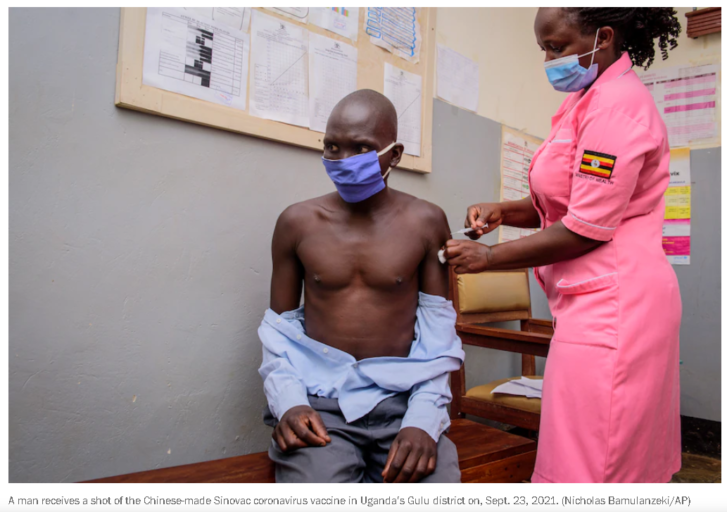When the World Health Organization gave its backing to two coronavirus vaccines produced by Chinese companies early this year, global health experts greeted the move as a much-needed boost to international vaccine supply.
After Sinovac became the second Chinese-made vaccine to receive WHO emergency-use listing in June, China’s Foreign Ministry spokesman Wang Wenbin called the twin vaccines “powerful tools for the world to overcome the epidemic at an early date.”
As of last month, China has exported 1.2 billion doses of vaccines, largely made by Sinopharm and Sinovac, according to the Foreign Ministry.

But this week, a new WHO decision has cast fresh doubt on the continued efficacy of Chinese-made vaccines for many millions who had received them. The new recommendation means people who had received two doses of either Sinopharm or Sinovac could seek third doses, potentially of another vaccine, constraining an already limited global supply.
In China alone, this could mean the need to administer tens of millions more doses. It may also hasten a trend of countries that had previously sought Chinese vaccines seeking Pfizer and Moderna doses — Western-developed mRNA vaccines that offer higher efficacy against covid-19 at a steeper price.
In an announcement Monday, the WHO confirmed that an independent panel of experts had recommended that anyone over 60-years-old receiving doses of Sinopharm and Sinovac should be offered an extra dose, either of the vaccine already administered or of a separate vaccine.
The news was a surprise to many who track vaccines. It was a “big potential development, with potential to increase significantly the demand on global vaccine supplies,” Tom Bollyky, director of global health at the Council on Foreign Relations, wrote on Twitter.
While many nations are already recommending booster shots amid the threat from the coronavirus’s delta variant, the WHO has been cold on the idea of extra jabs. Citing the desperate need for first doses in many low-income nations, WHO officials have called for a moratorium on booster shots till the end of the year.
The Strategic Advisory Group of Experts on Immunization (SAGE) recommendations after a meeting last week were framed not as booster shots but as a third dose offered to certain groups to meet the level expected from routine immunizations of WHO-backed vaccines.
“That’s a distinct thing from giving additional doses, booster doses, to people who have had an adequate primary response to vaccination,” WHO vaccine director Kate O’Brien told reporters Monday.
Even so, many countries that administered Chinese vaccines have already begun giving out third doses as booster shots, often to far wider populations than just those over 60 years old.
Doubts over Sinopharm and Sinovac may even extend to Beijing: Chinese publication Caixin reported in July that officials were reportedly considering offering third doses co-developed with German company BioNTech.
These shifts may increase supply strains on vaccines developed by Pfizer and Moderna, which use new mRNA technology rather than the older technology used by Sinopharm and Sinovac, which employ a deactivated version of the virus to provoke an immune response to the coronavirus.
SAGE’s recommendations affected not only Chinese vaccines. The panel also recommended that people with weakened immune systems should be offered an additional coronavirus vaccine dose no matter what WHO-backed vaccine they used.
But the blanket recommendation of third doses for those over 60 receiving Chinese vaccines could well have a larger impact. Almost 1 in 5 among China’s population of 1.4 billion are over 60. China claims to have administered 2.2 billion doses domestically.
These vaccines are not only widely used in China, the most populous country on earth, but they have been sold to countries in Latin America, the Middle East and Africa, in what some critics have dubbed vaccine diplomacy.
China has also pledged to earmark 67.8 million doses for donation to 93 countries, including many doses through the WHO-backed vaccine-sharing Covax initiative, which helps low-income nations find doses.
According to the Council on Foreign Relations’ Think Global Health project, which is tracking vaccine donations around the world, 49.5 million Chinese doses had been delivered by late September — more than other country except the United States.
Speaking to reporters Monday, Joachim Hombach, secretary for the panel, said that data from Sinopharm and Sinovac “clearly showed” that “the vaccine performs less well after two doses” in those over 60 and that they expected “much better protection.”
WHO regulators had previously noted gaps in the data about the efficacy of the Chinese vaccines. In May, a WHO panel said it had “low level of confidence” in Sinopharm’s efficacy in people 60 and older, and a “very low confidence” about potential side effects in that age group, due to a lack of data.
SAGE chair Alejandro Cravioto said that most of the information for the new decision had come from Latin America, where third doses are already being widely offered to those who received Chinese doses. “These are studies that have been conducted in Chile and Brazil and Argentina,” Cravioto said.
In August, Turkey began offering third shots of Pfizer vaccines to anyone who had been immunized with Sinovac, citing the wider international acceptance of the former rather than the efficacy of the latter.
According to Think Global Health, by mid-August almost “85 percent of all countries currently administering booster doses” had relied on Chinese vaccines.
Speaking to reporters Monday, SAGE experts said that countries administering Sinopharm and Sinovac should still try to maximize two-dose coverage before administering third doses, but admitted that the change in recommendations for Chinese vaccines could have a wider impact.
“We are totally aware that this has implications on supply,” Hombach said. “But it’s also very important for the global community to understand where … the supply and demand for vaccines is moving to.”
Article From: Washington Post
Author: Adam Taylor

